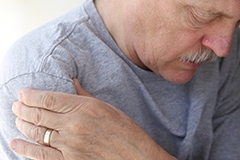Rotator Cuff Injury: Too Much Shoulder to the Wheel
Medically Reviewed by Patrick K. Denton, MD
Your doctor lifts your arms up over your head. Then, you are asked to slowly drop your arms down by your side. Both arms slowly move until they are straight out from the shoulder. As you continue, one arm just falls quickly to your side.
Sometimes a diagnosis does not require the use of diagnostic testing equipment. In this case, the simple (and simply named) “Drop Arm Test” can tell your Orthopedic Specialist if an important group of muscles in your shoulder – the rotator cuff — is torn.
What is a Rotator Cuff?
The rotator cuff is a group of 4 muscles on the shoulder that work with tendons to attach the “ball” on the upper arm to the “cup” in the shoulder.
In addition to keeping the shoulder joint in place, the rotator cuff helps you lift things over your head and rotate your arms.
What Causes Rotator Cuff Tear
Inflammation or tearing of the rotator cuff is the most common shoulder injury.
Inflammation develops slowly. Bone spurs irritate the muscles and tendons. Sometimes it is simply from continuous use over the years that trigger the irritation.
A tear normally results from a sudden fall or injury involving your shoulder or outstretched arm, most commonly to people over age 40. Throwing, painting or careers involving lifting can end up tearing the rotator cut.
Rotator Cuff Injury Symptoms
- Pain. You’ll feel mild to sharp pain on the top and in the front of the injured shoulder. It might spread down the side of the upper arm. And it may be severe enough to interrupt your sleep.
- Swelling. Swelling is your body’s natural response mechanisms. It often triggers pain.
- Weakness & Loss of Function. You will find limited range of motion and the inability to lift items over your head. This may limit your ability to undertake simple tasks, such as combing your hair or dressing yourself.
Treatment for Rotator Cuff Injuries
Without Surgery: Personal physicians or Orthopedic Specialists first try conservative treatments involving medication and physical therapy. These treatments may reduce the pain and resolve the inflammation. However, if your rotator cuff is torn, the only way to fix the problem is surgery.
When surgery is needed:
- It is time for surgery if:
1) The symptoms have lasted 3 to 6 months
2) You have had a recent acute injury
- A partial tear can be repaired by sewing the two separate pieces back together.
- A complete tear — going all the way through the tendon — requires reattaching the tissue to the bone.
Your Recovery
Surgery is performed on an outpatient basis. However, the recovery and rehabilitation takes time and commitment on your part.
For about 4 to 6 weeks your arm will be immobilized in a sling.
Your surgeon and physical therapist will determine when you can start “passive exercises,” where the therapist moves your arm into different positions. This is generally 4 to 6 weeks after surgery.
About 6 to 8 weeks after surgery, you will start “active exercises,” where you will move your arm without the help of the therapist.
Therapy advances to a strengthening program usually around 8 to 12 weeks after surgery.
Four to 6 months after surgery most patients will see the return of range of motion and strength.
Don’t Wait
An injured or torn rotator cuff does not improve on its own. Contact your personal physician or an Orthopedic specialist to avoid further injury from the problem.
-
McLEOD REGIONAL MEDICAL CENTER FLORENCE
843-777-2000 -
McLEOD DARLINGTON
843-777-1100 -
McLEOD DILLON
843-774-4111 -
McLEOD LORIS
843-716-7000 -
McLEOD SEACOAST
843-390-8100 -
McLEOD CHERAW
843-537-7881 -
McLEOD CLARENDON
803-433-3000



-
McLEOD REGIONAL MEDICAL CENTER FLORENCE
843-777-2000 -
McLEOD DARLINGTON
843-777-1100 -
McLEOD DILLON
843-774-4111 -
McLEOD LORIS
843-716-7000 -
McLEOD SEACOAST
843-390-8100 -
McLEOD CHERAW
843-537-7881 -
McLEOD CLARENDON
803-433-3000
 Find a Doctor
Find a Doctor  Locations
Locations  Services
Services 